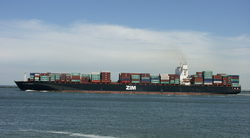Zim falls into the red in second quarter

Along with most other container lines, the impact of low freight rates and higher bunker costs have taken their toll on the independent Israeli carrier
Despite higher liftings and revenues, operating costs lead Zim to a net loss.
INDEPENDENT Israel-based container line Zim has slumped to a $33.2m loss in the second quarter of the year, despite increasing its volumes by 17% and its revenues by 7.7%.
In what has become a familiar refrain across the industry, Zim’s revenue increase was hit by increased bunker prices and lower rates. Zim’s average freight rate fell from $1,007 per teu in the corresponding quarter of 2017 to $907 per teu in the second quarter of this year.
“The second quarter of 2018 was characterised by the continued rise in fuel prices and chartering rates, as well as low freight rates, all with a negative impact on the results of carriers, including Zim,” said chief executive Eli Glickman.
Zim said the “instability and volatility” in the market, including significant uncertainties in the global trade, continued to affect the market environment.
“Since the second half of 2016 and through the third quarter of 2017, increases were recorded in freight rates as well as in bunker prices,” Zim said. “Commencing the fourth quarter of 2017, freight rates have decreased, while bunker prices as well as charter rates continued to increase. As a result, the industry was negatively affected in first half of 2018 compared with the same period of 2017.”
Despite carried volumes rising from 659,000 teu in the second quarter of 2017 to 772,000 teu in the current reporting period, adjusted ebitda fell from $70.1m to $23.1m in the same period. Total revenues were $803.2m.
But Mr Glickman said Zim’s recent announcement of long-term strategic co-operation with the 2M Alliance in the Pacific-US east coast trade was evidence of the company’s strength and performance. “This agreement is expected to bring considerable efficiencies and savings, along with a far improved service portfolio, supporting ZIM’s strategy going forward.
He added that despite the adverse circumstances, Zim was able to record an adjusted ebit margin above industry average.